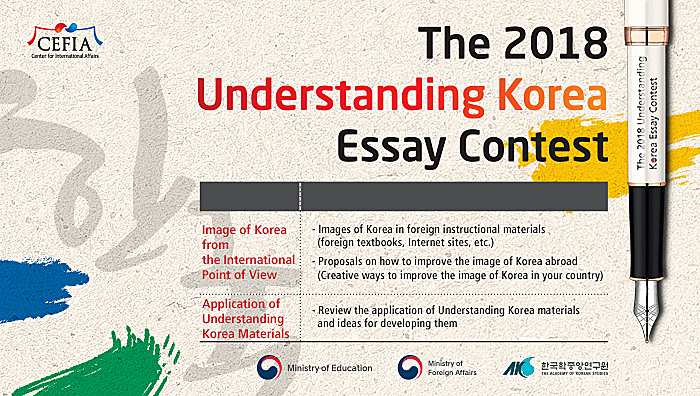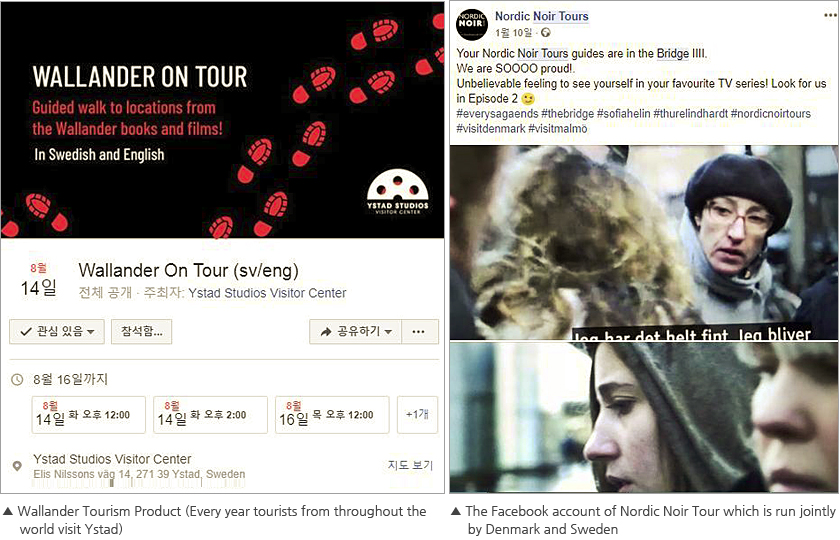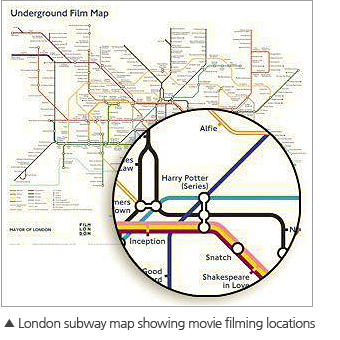Essay Contest Result

A Proposal for Content Development
for Korean Noir Film Tourism
In recent times, there has been a change in the types of questions asked by foreigners about South Korea. Increasingly they are asking more questions about provincial regions like Busan and Milyang. Many seem to want to know more about other Korean cities besides Seoul, but the lack of information has failed to satiate their curiosity. Apparently, their interest developed after watching Korean movies like Milyang and Train to Busan. Funnily enough, there are many Korean films that are titled after Korean provincial regions, such as Milyang, Yeongdo, Haeundae, Goksung, Yeouido, Train to Busan and Joint Security Area. Curiosity of South Korea’s regional film locations piqued by mass media, which often leads to interest in Korean society, can turn these regions into tourist attractions.
There has been a similar phenomenon in Northern Europe. In recent years Scandinavian countries have been using Scandi (or Nordic) noir novels and film noir in their strategies to increase tourism. Sweden is a country at the vanguard of the Nordic Noir Tour movement, whose beginnings can be traced back to the publication of Wallander (See Figure 1), a crime novel by Swedish writer Henning Mankell. In Europe, tourist attractions based on film noir are well developed. In the UK the Jack the Ripper Tour, which was launched in 1982, has helped promote the East End, a then underdeveloped district of London, while the Sherlock Tour of the filming locations of the BBC drama Sherlock also remains popular. Sweden is no exception in this respect. The small rural town of Ystad, which was the setting of Wallander, was developed into a movie town in the 1990s and since then it has become a mecca for Australian, Japanese and German fans of the series. In recent years, because of the popular thriller drama The Bridge (See Figure 2), which is based on the Oresund Bridge connecting Denmark and Sweden, tourists are flocking to Malmö and Oresund Bridge, which served as the backdrop for the drama.
There has been a similar phenomenon in Northern Europe. In recent years Scandinavian countries have been using Scandi (or Nordic) noir novels and film noir in their strategies to increase tourism. Sweden is a country at the vanguard of the Nordic Noir Tour movement, whose beginnings can be traced back to the publication of Wallander (See Figure 1), a crime novel by Swedish writer Henning Mankell. In Europe, tourist attractions based on film noir are well developed. In the UK the Jack the Ripper Tour, which was launched in 1982, has helped promote the East End, a then underdeveloped district of London, while the Sherlock Tour of the filming locations of the BBC drama Sherlock also remains popular. Sweden is no exception in this respect. The small rural town of Ystad, which was the setting of Wallander, was developed into a movie town in the 1990s and since then it has become a mecca for Australian, Japanese and German fans of the series. In recent years, because of the popular thriller drama The Bridge (See Figure 2), which is based on the Oresund Bridge connecting Denmark and Sweden, tourists are flocking to Malmö and Oresund Bridge, which served as the backdrop for the drama.

 |
How then might we apply noir film tourism to the goal of promoting South Korea? First, it should be possible to reorganize existing Korean promotional materials so as to focus on the contents of Korean film tourism. The modern era is also considered to be an “age of curation” because the reorganization of contents around a specific theme has become popular. This is because delivering information in a storytelling format centered on a specific theme is more compatible with current public tastes than the encyclopaedic listing of the massive amounts of knowledge we have at our disposal. For example, the Cultural Landscapes of Korea (2010) is an excellent material for a case study, but it also seems to be too broad in scope, as seen even from just the title. If the scope could be narrowed by re-adapting it as The Noir Filmscape in Korea, for example, and by including materials like a Seoul subway map or a national map of filming locations (See Figure 3), then the material could be used more practically in promoting the country. |
Each chapter could introduce novels, movies, and dramas where a specific region is the backdrop of the story. Or each chapter could feature actors and singers who hail from a given region. Furthermore, the material could be supplemented with descriptions of the region’s history, legends, local specialties and traditional cuisine and customs. If a movie or character-based representation of a region is developed into a tourism product, the tourism resources of a region could be differentiated, and could also contribute to more balanced regional development. For example, one carriage on the KTX train departing for Busan from Seoul could be made into the Zombie Tour Event. Films or quiz/games that inform the participants about each train station could be organized for international passengers. The carriage could also be used as a venue for cultural exchanges between foreign tourists and Koreans.
Second, the platform of Korean promotional materials could be diversified and utilized to deliver information to western tourists who are geographically too far away and have relatively fewer opportunities for travel. Apps could be developed and foreign YouTubers appointed as ‘influencers’ of the Korean Cultural Exchange Center’s YouTube account could upload 2~5-minute-long V-logs about the different regions of South Korea in their native languages. For example, a video titled ‘The setting for the movie Paju and the history of Paju’s famous sites’ produced in Spanish with English subtitles could be uploaded to YouTube. The results of a survey that I conducted as a part of my research in graduate school indicated that for tourists in geographically distant regions like Europe, platforms such as YouTube and Google function essentially as channels of publicity. However, there is such a dearth of good quality material in English about South Korea. As a matter of fact there were some European students who were interested in writing their thesis on the issue of gender conflicts/comfort women and military/generational conflicts, but because most of the accessible information on the Internet is in Korean, students felt limited by the lack of accessible information. Watching them give up one after another truly broke my heart.
Third, contents based on IT could be developed. For example, through QR codes inserted in Korean promotional materials, foreign visitors could receive supplementary images and materials by scanning the QR code with their smartphones. And if virtual reality (VR) contents could be produced about everyday life in the historical periods depicted in films, a very realistic experience could be provided to them.
Of all the genres available to us, I am proposing film noir because, firstly, this genre is particularly well suited to conveying the complex social issues present in Korean society and some aspects of our national psyche that can be difficult to put into words. During some of the interviews I conducted as part of the survey, watching how interest initially triggered by Korean pop culture could evolve into a deeper understanding of Korea through noir suggested to me that there was a sustainable way for promoting our national image. I had reservations that noir would cast a rather negative light on Korean society. However, most of the responses from foreigners were positive, as illustrated by the remarks of a 20- year-old Swedish woman: “I came to love South Korea more because film noir gave me a more balanced view of diverse facets of Korean society”. BTS is an idol group whose lyrics address some of the darker aspects of South Korea, like school bullying and violence and the pressure cooker society. But this is precisely the reason why they have attracted a worldwide following. The limitations of the strategy pursued by past pop culture-based tourism was that it touched upon universal sentiments while appealing to one’s emotions by occasionally tossing in a heavy topic here and there. And therefore it was short-lived.
Second, there has been many responds to a survey where people felt that the image of Korea projected in popular culture revolving around social problems was more in touch with reality than official data published by the government. In fact, according to a study published by the European Commission in 2013, European tourists stated that they preferred information obtained from online websites (46%) and recommendations from friends (56%) than from the official data (21%) published by institutions. Therefore, the South Korean government should actively employ these YouTube ‘influencers’ in its national image enhancement strategy.
Third, as mentioned above, noir tourism has become a global trend. On October 19 last year, the London Korean Film Festival (The Independent, 2017) held a special screening focused on Korean film noir. In a timely manner, the international press (The Guardian, 2018) has also described Korean thriller writers as a group of creative artists who could lead the post-Scandi noir movement. I could also sense the potential of this trend succeeding in an interview (see below) I had with a film studio executive in Ystad, Sweden.
“Henning Mankell’s goal was not only for readers to consume his novels; rather, he also wanted them to feel Ystad and experience Swedish society. It can be said that he had clairvoyance. And how has it turned out, fourteen years later? By literally turning on the TV, you can enjoy Nordic noir every day, wherever you are in the world!”
– Excerpt from an interview with Jack, a Ystad-Wallander tour guide. (July 19, 2018) –
There was a time when the slogan "South Korea - Asia's Best Kept Secret" (Avraham & Ketter, 2008) was well received by foreigners in the early 2000s for the way it turned Korea’s weak brand image into a clever catch phrase. But today, when the desire and demand to know more about Korea is greater than ever before, I feel the time has come to fully unveil the charms our country has to offer. I hope that my article will contribute in some small but meaningful way to the development of contents that could serve this purpose.
2. European Commission (2013). Attitudes of Europeans towards Tourism, Flash Eurobarometer 370, 1-178.
3. Flood, A. (2018, March, 3rd). ‘The new Scandi noir? The Korean writers reinventing the thriller’. Retrieved from The Guardian:
https://www.theguardian.com/books/2018/mar/03/the-new-scandi-noir-the-korean-writers-reinventing-the-thriller
4. Kemp, P. (2017, November, 7th). ‘The world of Korean noir: Extreme violence, dwelt on with relish, seems to be de rigueur’. Retrieved from The Independent:
https://www.independent.co.uk/arts-entertainment/films/features/london-korean-film-festival-film-noir-park-chan-wook-oldboy-the-merciless-a8042711.html
Second, the platform of Korean promotional materials could be diversified and utilized to deliver information to western tourists who are geographically too far away and have relatively fewer opportunities for travel. Apps could be developed and foreign YouTubers appointed as ‘influencers’ of the Korean Cultural Exchange Center’s YouTube account could upload 2~5-minute-long V-logs about the different regions of South Korea in their native languages. For example, a video titled ‘The setting for the movie Paju and the history of Paju’s famous sites’ produced in Spanish with English subtitles could be uploaded to YouTube. The results of a survey that I conducted as a part of my research in graduate school indicated that for tourists in geographically distant regions like Europe, platforms such as YouTube and Google function essentially as channels of publicity. However, there is such a dearth of good quality material in English about South Korea. As a matter of fact there were some European students who were interested in writing their thesis on the issue of gender conflicts/comfort women and military/generational conflicts, but because most of the accessible information on the Internet is in Korean, students felt limited by the lack of accessible information. Watching them give up one after another truly broke my heart.
Third, contents based on IT could be developed. For example, through QR codes inserted in Korean promotional materials, foreign visitors could receive supplementary images and materials by scanning the QR code with their smartphones. And if virtual reality (VR) contents could be produced about everyday life in the historical periods depicted in films, a very realistic experience could be provided to them.
Of all the genres available to us, I am proposing film noir because, firstly, this genre is particularly well suited to conveying the complex social issues present in Korean society and some aspects of our national psyche that can be difficult to put into words. During some of the interviews I conducted as part of the survey, watching how interest initially triggered by Korean pop culture could evolve into a deeper understanding of Korea through noir suggested to me that there was a sustainable way for promoting our national image. I had reservations that noir would cast a rather negative light on Korean society. However, most of the responses from foreigners were positive, as illustrated by the remarks of a 20- year-old Swedish woman: “I came to love South Korea more because film noir gave me a more balanced view of diverse facets of Korean society”. BTS is an idol group whose lyrics address some of the darker aspects of South Korea, like school bullying and violence and the pressure cooker society. But this is precisely the reason why they have attracted a worldwide following. The limitations of the strategy pursued by past pop culture-based tourism was that it touched upon universal sentiments while appealing to one’s emotions by occasionally tossing in a heavy topic here and there. And therefore it was short-lived.
Second, there has been many responds to a survey where people felt that the image of Korea projected in popular culture revolving around social problems was more in touch with reality than official data published by the government. In fact, according to a study published by the European Commission in 2013, European tourists stated that they preferred information obtained from online websites (46%) and recommendations from friends (56%) than from the official data (21%) published by institutions. Therefore, the South Korean government should actively employ these YouTube ‘influencers’ in its national image enhancement strategy.
Third, as mentioned above, noir tourism has become a global trend. On October 19 last year, the London Korean Film Festival (The Independent, 2017) held a special screening focused on Korean film noir. In a timely manner, the international press (The Guardian, 2018) has also described Korean thriller writers as a group of creative artists who could lead the post-Scandi noir movement. I could also sense the potential of this trend succeeding in an interview (see below) I had with a film studio executive in Ystad, Sweden.
“Henning Mankell’s goal was not only for readers to consume his novels; rather, he also wanted them to feel Ystad and experience Swedish society. It can be said that he had clairvoyance. And how has it turned out, fourteen years later? By literally turning on the TV, you can enjoy Nordic noir every day, wherever you are in the world!”
– Excerpt from an interview with Jack, a Ystad-Wallander tour guide. (July 19, 2018) –
There was a time when the slogan "South Korea - Asia's Best Kept Secret" (Avraham & Ketter, 2008) was well received by foreigners in the early 2000s for the way it turned Korea’s weak brand image into a clever catch phrase. But today, when the desire and demand to know more about Korea is greater than ever before, I feel the time has come to fully unveil the charms our country has to offer. I hope that my article will contribute in some small but meaningful way to the development of contents that could serve this purpose.
[Reference]
1. Avraham, E., & Ketter, E. (2013). Marketing destinations with prolonged negative images: Towards a theoretical model. Tourism Geographies, 15(1), 145-164.2. European Commission (2013). Attitudes of Europeans towards Tourism, Flash Eurobarometer 370, 1-178.
3. Flood, A. (2018, March, 3rd). ‘The new Scandi noir? The Korean writers reinventing the thriller’. Retrieved from The Guardian:
https://www.theguardian.com/books/2018/mar/03/the-new-scandi-noir-the-korean-writers-reinventing-the-thriller
4. Kemp, P. (2017, November, 7th). ‘The world of Korean noir: Extreme violence, dwelt on with relish, seems to be de rigueur’. Retrieved from The Independent:
https://www.independent.co.uk/arts-entertainment/films/features/london-korean-film-festival-film-noir-park-chan-wook-oldboy-the-merciless-a8042711.html

